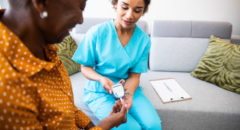
When we think of diabetes, we think of problems with blood sugar. We think of dieting and insulin. We think of symptoms like fatigue, thirst, weight loss, and issues healing. We think of possible serious events, like strokes and heart attacks. Perhaps we even face the possibility of limb amputation down the road…
But what about something outside the health concerns? What about financial concerns?
Here are important areas you need to know so you can get your money right and keep your diabetes under control for Life.
Insurance Coverage
Know the basics. Understanding your insurance coverage is one of the first things you should do when diagnosed with diabetes. If you’re feeling overwhelmed or simply don’t understand some of the terms or language used, don’t fret.
Let’s break it down:
- Copays: The fixed amount you have to pay for healthcare. This could be things like going to the doctor or getting your meds.
- Deductibles: This refers to out-of-pocket costs you pay. In other words, this is the amount you have to pay until your insurance coverage takes over.
- Premiums: These are the routine amounts you pay to keep your insurance coverage.
- Out-of-Pocket Maximum: Are you spending a lot per year on healthcare services? This term refers to the maximum amount you pay for services under your insurance in one year. If you hit this number, your insurance then covers everything from there.
If you’re confused about any of this, make sure to look at your plan. With diabetes, some things are covered while others are not. If you require meds, monitors, or test strips, it’s important to see if they’re covered. Also, consider coverage of things like special visits.
Not sure? Call your insurance company for details.
Get Assistance
There are plenty of government and nonprofit programs to help you cover your costs. Of course, first, you gotta know where you fit in. If you’re over 65, Medicare may be for you. If you struggle with low income, Medicaid may be for you.
You can also look into what are called pharmaceutical assistance programs. If you qualify, you can get your meds partially or even fully covered. And finally, look into foundations and associations. The American Diabetes Association and the Juvenile Diabetes Research Foundation are great sources.
They may even provide financial assistance if you meet the criteria.
Plan for Emergencies
Life happens and sometimes we face a crisis without any warning. If something’s happened that caught you off guard, don’t feel alone. Starting now, it’s time to build an emergency fund.
An emergency fund is exactly like it sounds. And the good news is, you can make it as big or small as you want. So set a goal. Try to save up to three to six months of living expenses. You can even talk to your bank about setting automatic transfers. This way, a part of your paycheck/income will still go into the fund if you forget. Start small, stay consistent, and watch it grow.
And finally, get rid of waste. It can be tempting, but you should try to cut back on unimportant expenses. Have unhealthy habits that drain your wallet? Now’s the time to kill two birds with one stone!
RELATED: 4 Life-Saving Resources for Black Diabetics
Federal Spending and Savings Accounts
They’re called Flexible Spending Accounts (FSAs) and Health Savings Accounts (HSAs).
With FSAs, you work with employer-sponsored accounts. Just one thing to remember. In most cases, you have to use the funds within the year or lose them. HSAs are different. While these are usually only for people with high-deductible health plans, the HSA funds can be rolled over.
Just be sure to see if you’re eligible based on your plan, and contribute to the accounts as consistently as you can.
Financial Planning
A financial planner is a great asset if you need guidance and want a comprehensive strategy for managing your health expenses. A planner can formulate a plan based on your income, expenses, objectives, and other financial concerns.
When it comes to getting the best planner, do some research. Some specialize in clients with chronic conditions like diabetes. Also be sure your planner is certified, usually with a Certified Financial Planner (CFP) certification.
When you go in for your meeting, get your paperwork together and have your expenses documented. Try to get a clear idea of your goals. Although they may change once you meet, it’s a good idea to have a starting place.
And when it comes to managing the costs of diabetes, starting well and staying strong is what matters most!









